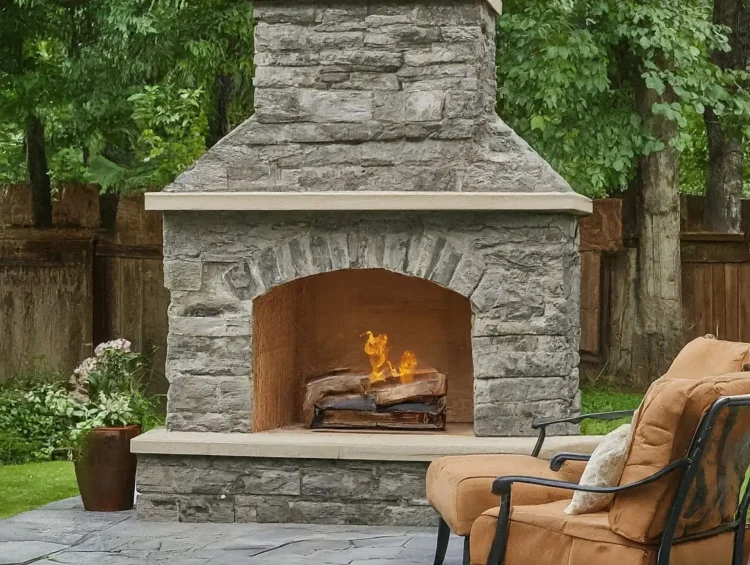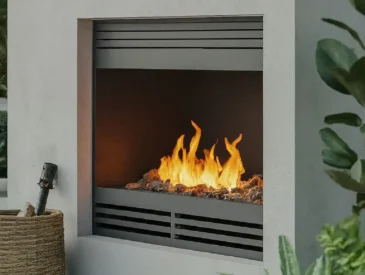Outdoor fireplaces are a captivating addition to any patio or backyard, elevating the ambiance of your outdoor living space. A common query that homeowners often grapple with is the necessity of a vent for their outdoor fireplace.

This article aims to shed light on whether outdoor fireplaces require a venting system and explores the various types of venting methods available on the market.
Do outdoor fireplaces need venting?
In most cases, outdoor fireplaces do require a venting system to function optimally. The majority of freestanding fireplaces operate on either gas or wood as their primary fuel source. Consequently, a chimney or flue is typically essential to expel smoke and byproducts efficiently. However, it’s worth noting that not all outdoor fireplaces necessitate a vent; some contemporary models are designed with ventless configurations.
Understanding Venting Methods:
1 Traditional Vents: Freestanding fireplaces using wood or gas generally require a traditional venting system. This involves the installation of a chimney or flue to channel smoke away from the living space.
2 Ventless Designs: Modern outdoor fireplaces often feature ventless designs. These innovative models utilize advanced technology to burn fuel cleanly, eliminating the need for a venting system. Ventless fireplaces are a popular choice for those seeking a streamlined and hassle-free heating option.
Why Venting Matters:
Efficient venting is crucial for the following reasons:
1 Smoke Dissipation: Proper venting ensures that smoke is directed away from the living area, preventing it from becoming a nuisance or health hazard.
2 Release of byproducts: A venting system helps expel byproducts, such as carbon monoxide and other potentially harmful gases, reducing the risk of indoor air pollution.
3 safety and Compliance: Adhering to venting requirements is essential for safety and compliance with local building codes and regulations.
Whether you’re in the process of shopping for an outdoor fireplace or conducting preliminary research, understanding the venting requirements is pivotal to making an informed decision.
While most outdoor fireplaces necessitate a venting system, the availability of ventless designs offers a versatile range of options. By delving into the intricacies of venting methods,
you’ll be equipped to make a confident choice regarding the purchase of your outdoor fireplace. Elevate your outdoor living experience with a well-informed decision today!
Venting Options for Outdoor Fireplaces: Making the Right Choice for Your Space
Outdoor fireplaces are a wonderful addition to any patio or backyard, creating a warm and inviting atmosphere. One crucial consideration for homeowners is whether a venting system is necessary. In this article, we’ll explore the importance of venting and highlight various options, including the unique benefits of outdoor ethanol fireplaces.
Venting for Safety and Comfort:
For most outdoor fireplaces, a venting system is essential to ensure proper functionality and to maintain a safe environment for those gathered around. This prevents an excess of smoke and harmful byproducts from accumulating in the vicinity. An exception to this rule is the outdoor ethanol fireplace, which operates efficiently without the need for venting.
Chimeneas: A Stylish and Efficient Choice: Chimeneas, characterized by their wide openings and often crafted from terracotta or metal, offer an elegant solution to venting. The vertical chimney effectively directs smoke away from the seating area while radiating heat outward.
This design not only accelerates the fireplace’s heating process but also contributes to a smoke-free outdoor space, making it a popular choice, particularly for families with young children.
Direct Vent Technology: Ensuring Safety Indoors: Other outdoor fireplace options typically require venting through direct vent technology. This system employs a sealed combustion process that draws in outside air for the fire, expelling combustion exhaust and unwanted byproducts safely outside the home.
Doing so maintains indoor air quality and prevents lingering gases from affecting you and your guests.
Ethanol Fireplaces: A Vent-Free Alternative: Ethanol fireplaces offer a unique advantage by operating efficiently without the need for a venting system. While producing real flames, these eco-friendly fireplaces derived from renewable sources like corn generate less heat compared to traditional wood-burning alternatives.
This makes them an excellent choice for those concerned about ventilation or residing in warmer climates. When selecting an outdoor fireplace, considering venting options is crucial for both safety and comfort.
While many models require venting for proper operation, outdoor ethanol fireplaces provide a vent-free alternative. With their efficient and eco-friendly design, they offer a fantastic solution for those seeking a hassle-free and stylish heating option. Elevate your outdoor space with the perfect fireplace choice today!
Understanding Venting Requirements for Outdoor Gas Fireplaces
When it comes to outdoor gas fireplaces, understanding the need for proper venting is crucial for both safety and functionality. In this article, we’ll explore the different types of gas fireplaces and their respective venting requirements.
Gas-Powered Fireplaces: Venting Essentials
Most gas-powered outdoor fireplaces require appropriate venting along with a dedicated gas line. However, there is a notable exception: ventless fireplaces. These units are designed to burn combustion byproducts without venting efficiently.
Direct Vent Gas Fireplaces: External Venting Solution
Direct-vent gas fireplaces are designed to be vented directly from the exterior of a home. They operate by drawing in outside air through the outer chamber of a vent pipe while simultaneously exhausting fumes through the inner chamber. This design ensures efficient ventilation while maintaining indoor air quality.
Chimney Vent for Safety:
In addition to a high-temperature glass panel and protective screen, a chimney vent is essential for gas fireplaces. This component is a barrier, preventing flames and combustion byproducts from escaping into the indoor environment. It serves as an integral safety feature for gas-powered fireplaces.
Natural Vent Gas Fireplaces: Utilizing Existing Chimneys
Natural vent gas fireplaces rely on existing masonry chimneys or factory-made metal chimneys for venting. These chimneys serve as conduits to safely expel potentially harmful fumes. Combustion byproducts exit through a single pipe within the chimney or a flexible liner, allowing for efficient ventilation.
Protective Flue Liners:
It’s worth noting that both types of chimneys (masonry and factory-made) should be equipped with a flue liner. This crucial component safeguards against corrosive substances from within. If your chimney exhibits exposed bricks and mortar, it indicates an unlined chimney that may require attention.
Vent-Free Ethanol-Powered Fireplaces: Clean and Convenient
Ethanol-powered gas fireplaces offer a vent-free solution, as they are designed to safely burn and disperse byproducts directly into the room. These innovative fireplaces utilize catalytic converter technology, which not only efficiently burns fuel but also cleans the air as it exits the combustion chamber.
Understanding the venting requirements for outdoor gas fireplaces is paramount for a safe and functional addition to your outdoor space. Whether opting for a direct-vent gas fireplace, utilizing an existing chimney,
or choosing a vent-free ethanol-powered unit, ensuring proper ventilation ensures a comfortable and secure outdoor living experience. Choose the right option for your space, and enjoy the warmth and ambiance of your gas fireplace to the fullest!
Venting Considerations for Outdoor Wood-Burning Fireplaces and Inserts
When it comes to outdoor wood-burning fireplaces and inserts, understanding venting requirements is crucial for both safety and functionality. In this article, we’ll delve into the necessity of vents for different types of outdoor fireplaces and explore venting methods commonly used.
Venting for Wood-Burning Fireplaces: Outdoor wood-burning fireplaces generate a significant amount of smoke, even with a built-in smoke shelf. To safely direct this smoke away from your living space, a venting system is essential.
The Role of a Smoke Shelf: A smoke shelf serves as a crucial component in preventing downdrafts from redirecting smoke and undesirable toxins into your home. Located between the smoke chamber and the firebox, it also acts as a barrier to catch debris and rainwater that may enter the chimney.

Fireplace Inserts: Venting Options: Outdoor fireplace inserts are a versatile alternative to costly kits. They can be seamlessly integrated into various structures within your outdoor space. Depending on the type of insert—electric, gas, or wood—ventilation requirements may vary.
Electric Fireplace Inserts: Vent-Free Solution: Electric fireplace inserts, being the simplest of the three types, do not require venting due to the absence of combustion. This makes them an excellent option for spaces without access to natural gas or wood, providing the cozy ambiance of a real fireplace without the need for a vent.
Venting Methods for Gas Fireplaces: There are two primary venting methods for gas fireplaces: direct vent and ventless (or vent-free).
1. Direct Venting: A direct-ventilated system draws in oxygen and expels gases into the outside air through openings like chimneys or specially designed openings in chimineas. This widely used method was introduced in the 1980s and is the preferred choice for modern fireplaces.
2. Ventless Fireplaces: Ventless fireplaces rely on high burn temperatures to eliminate combustion byproducts without the need for physical vents or gas lines. This technology ensures that harmful toxins are effectively removed from the air, making venting unnecessary.
Natural Venting (B-Vent): Natural venting, also known as B-vent, is a less commonly used system that is not sealed. It operates by pulling air into the combustion chamber and expelling exhaust through a roof-mounted pipe.
Conclusion Understanding the venting requirements for outdoor wood-burning fireplaces and inserts is pivotal for a safe and enjoyable outdoor experience. Whether you opt for a traditional wood-burning fireplace or choose a convenient insert,
following the manufacturer’s instructions during installation ensures optimal performance. Elevate your outdoor space with the warmth and charm of a well-vented fireplace today!





